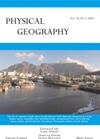使用地形形态结构框架的山过程状态表征
IF 1.4
4区 地球科学
Q4 ENVIRONMENTAL SCIENCES
引用次数: 0
摘要
摘要复杂的山地地球动力学由于大气、地表和构造过程相互作用产生的强迫因素、反馈机制和系统耦合而难以解耦。控制过程制度时空范围的操作规模依赖性和过程形式关系,反过来又控制救济生产,尚未得到充分的表征和映射。本研究建立了一个地形形态结构框架,用于表示和查询管辖并受山脉地球动力学控制的地形的空间组织结构。地形的空间尺度相关结构是利用地表参数和地表划分为代表地貌系统重要方面的不同地形单元来解释的。地形单元的特性和空间拓扑为建模过程-形态关系提供了约束,这些关系被表示为过程-形态指数,并使用逻辑回归进行综合,以在盆地尺度上以约80%的准确率实证检测喀喇昆仑中部31个盆地的冰川和基岩河流切割过程。地形形态-结构框架方法提供了一种机制,用于对尺度相关地形结构进行可处理的表示,以自动表征地表,通过定义的过程-形式关系深入了解多成因地貌系统和系统耦合。本文章由计算机程序翻译,如有差异,请以英文原文为准。
Mountain process regime characterization using a topographic morphological structural framework
ABSTRACT Complex mountain geodynamics are difficult to decouple due to forcing factors, feedback mechanisms, and system couplings that arise from interacting atmospheric, surface, and tectonic processes. The operational-scale dependencies and process–form relationships that govern the spatio-temporal extent of process regimes, which in turn govern relief production, have yet to be adequately characterized and mapped. This research establishes a topographic morphological structural framework for representing and querying the spatial organizational structure of the topography that governs, and is governed by mountain geodynamics. The spatial scale-dependent structure of the topography is accounted for using land-surface parameters and land-surface partitioning into distinct terrain units that represent important aspects of the geomorphological system. The properties and spatial topology of terrain units provide constraints for modeling process–form relationships, which are represented as process–form indices and synthesized using logistic regression to empirically detect glacial and bedrock river incision process regimes at the basin-scale for 31 basins in the Central Karakoram at about 80% accuracy. The topographic morphological structural framework approach provides a mechanism for tractable representation of scale-dependent topographic structure for automated characterization of the land surface, providing insight into polygenetic geomorphological systems and systems coupling through defined process–form relationships.
求助全文
通过发布文献求助,成功后即可免费获取论文全文。
去求助
来源期刊

Physical Geography
地学-地球科学综合
CiteScore
3.60
自引率
0.00%
发文量
18
审稿时长
6 months
期刊介绍:
Physical Geography disseminates significant research in the environmental sciences, including research that integrates environmental processes and human activities. It publishes original papers devoted to research in climatology, geomorphology, hydrology, biogeography, soil science, human-environment interactions, and research methods in physical geography, and welcomes original contributions on topics at the intersection of two or more of these categories.
 求助内容:
求助内容: 应助结果提醒方式:
应助结果提醒方式:


